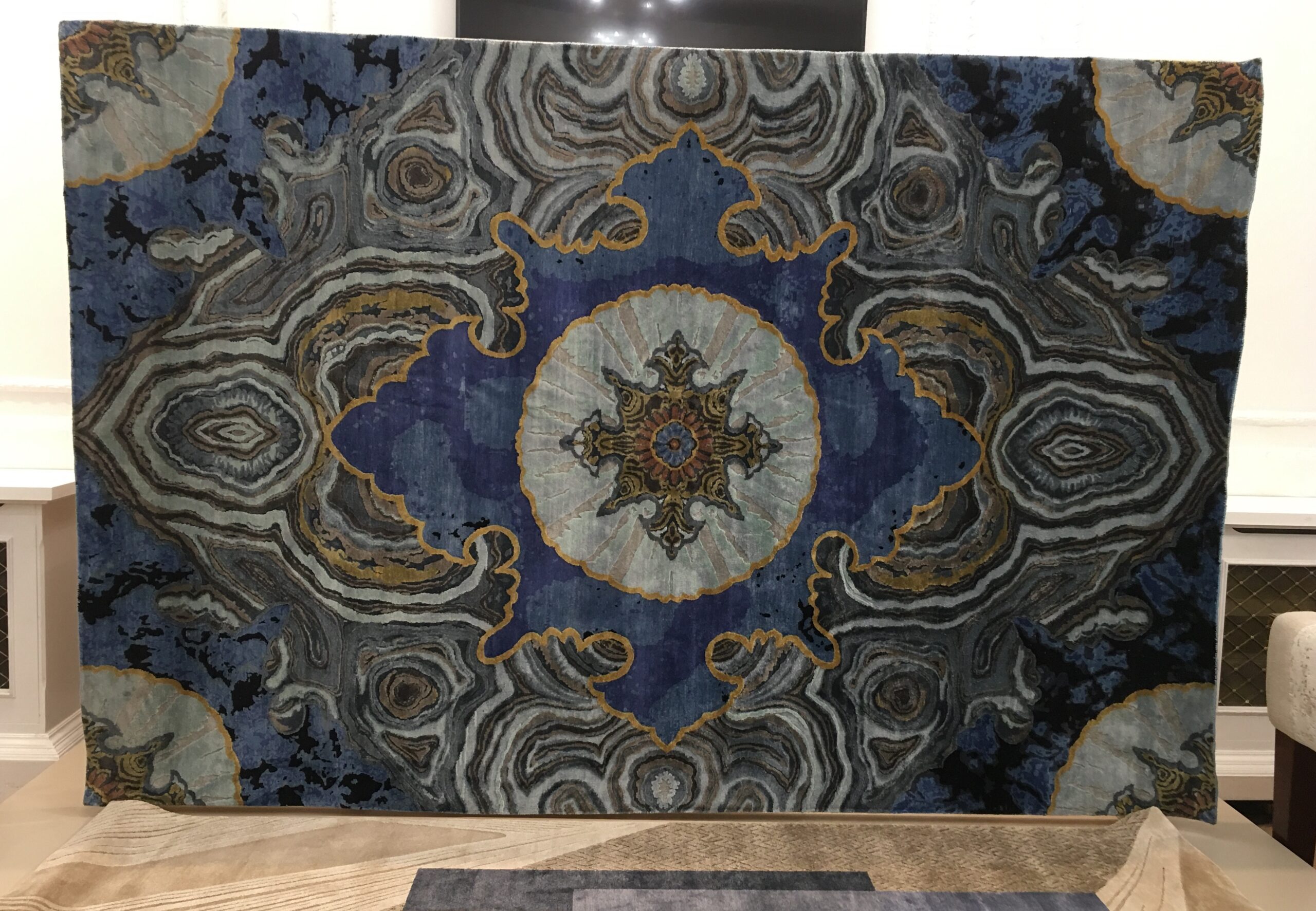The Nehru Centre in London, the cultural hotspot of The High Commission of India in the UK, hosted the ‘Woven Gems by Jocelyn Burton’ exhibition in May 2023. The collection showcased a range of handwoven carpets from India designed by Jocelyn Burton, a London-based jewellery designer, in collaboration with Jaipur Rugs (henceforth JR), a well-established carpet-manufacturing firm based in Rajasthan with over 40,000 artisans working for it.
The silk carpets on display were woven by over thirty carpet-weavers, mainly women from Rajasthan and Uttar Pradesh. The labour-intensive process of making carpets involves the work of many hands – from carding and spinning yarn, dyeing the yarn in an array of colours, weaving/ hand-knotting patterns on looms with meticulous precision, washing the carpets to enhance the underlying strength of the design, and subsequently finishing the process with a method called ‘Gultarash’, a technique that translates as ‘finding the flower’. This final stage involves assiduously trimming parts of the carpet to create a textured effect in order to accentuate the motifs and flower patterns in the design.
Take, for instance, the carpet named ‘Tapestry’ (image below). Drawing inspiration from Jocelyn Burton’s iconic Jerwood Necklace, this hand-knotted 6’6 ft x 10 ft carpet costs over £15,000 including import duty and haulage charges. The hefty price tag has to do with the nature of the fabric (silk) and the number of knots per square inch. The denser the knots, higher the price. The ‘Tapestry’ has 121 knots per square inch, hand-knotted by three female weavers on looms installed in their homes by JR over a period of six months.
This exhibition provided an analytical window into exploring the value chain for Indian handcrafted carpets in the UK market: from the hand-knotting artisans and contractors based in carpet-exporting regions in India to buying gents and customers in the UK.
From the perspective of Indian carpet-manufacturing firms, a number of sticking points emerge as far as trade with the UK is concerned. A high import duty on Indian hand-knotted carpets – a 20% VAT – has inhibited sales in the UK. Buyers who might be interested in purchasing Indian carpets are hard to access. They tend to be architects and/or interior designers based in the UK. They, in turn, recommend Indian carpet-making firms to their own clientele.
Indian carpet-making firms have found it difficult to woo UK-based buyers. Instead, they have turned to recruitment agencies to hire their ‘A&D Manager’ (Architects and Designers) who acts as an anchor point ‘on the ground’, connecting the firm with interior designers in the UK.
But, two problems arise. First, recruitment agencies tend to charge a double commission from both ends – employer and potential employee – often holding back on ‘good applicants’ at the first instance. The potential candidates for the job, based in the UK, tend to ask for a higher pay package compared to their Indian counterparts. Furthermore, some firms require their A&D Manager to undergo training in India in order to accurately represent the brand to foreign buyers. This has proven to be both costly and unproductive. Second, marketing strategies such as ‘cold calling’ designers for an appointment has proven to be ineffective. More prospective methods include giving promotional ‘goodies’ to potential buyers; ‘constant engagement’ through social media channels (e.g. sharing catalogues on Instagram and LinkedIn); organising all-expense-paid brunches and dinners for interior designers to showcase the firm’s products.
There are additional challenges associated with promotions in the foreign market. Often, Indian firms rely on Public Relations (PR) agencies to make recommendations on social events to promote the brand in the UK market. This too poses challenges. For instance, privately hosted exhibitions do not necessarily generate the kind of ‘buzz’ and foot-fall of designers that a firm might be expecting, as is common in international trade expos such as ‘Salone in Milan’, that brings together designers and exporting businesses from across the world. Privately hosted exhibitions can incur unanticipated expenses and overhead charges — building and dismantling frames on which expensive carpets are mounted, for instance, often entail hidden costs.
Well-established carpet-manufacturing companies in India that have an annual turnover of over two hundred and fifty crore Indian rupees (24 million pound sterling) are big players in India’s growing economy, both in terms of export and employment, especially for women, based in rural settings.
For Micro, Small and Medium Enterprises (MSMEs) in India’s carpet industry, however, the problems and prospects in exporting to the UK market are far more pronounced. Indian MSMEs have been at the forefront of bolstering India’s economic growth. Can MSME’s engaged in carpet-making in India overcome the export barriers? Does access to credit enable Indian MSMEs to successfully connect to global markets? And what role does social networks play in facilitating trade ties between MSMEs in India and the UK, especially in the context of the carpet industry. These questions are at the heart of ‘The Enablers and Obstacles for UK-India Trade’ project jointly undertaken by academics at King’s College London, Indian Institute of Management Bangalore, and non-academic partner Federation of Indian Chamber of Commerce and Industry (FICCI).
By Dr Humaira Chowdhury, Postdoctoral Research Associate at King’s India Institute, King’s College London.
Source: https://www.jaipurrugs.com/eu/rugs/sps-30-medium-sky-blue-blue-tapestry-rug


